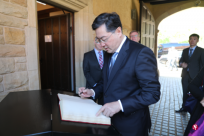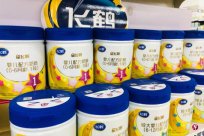China's April Consumer Price Index (CPI) increased to the lowest level in more than two years, and the production price index (PPI) decreased for seventh consecutive month. These two latest economic indicators, together with weak this week, weak this weekTrade data and the shrinking data of recent manufacturing activities show that China's domestic demand is still weak, and the efforts of China's economic recovery may be weakening.
The National Bureau of Statistics of China announced on Thursday (May 11) that the CPI in April rose 0.1%year -on -year, down 0.6 percentage points from March, setting the lowest level since February 2021, which is lower than the market expectations.
The State Bureau attributed the weaker price expansion index to the base effect.In April last year, the supply chain was severely frustrated due to seal control, and the people were forced to hoard food and other foods and pushed up prices.The decline in vegetable prices in April this year expanded to 13.5%. The weight of pork in the CPI basket was sufficient due to sufficient early production capacity, and the price increase decreased from 9.6%in March to 4.0%, down the inflation.
Wang Jun, chief economist of Huatai Assets Wang Jun, said in an interview with Lianhe Morning Post that Chinese prices continued to fall in April. In addition to factors such as base effects, pig cycles, and the country have not yet begun to store storage pork.Late to the bottom.
He said: "The scar effect brought by the epidemic, the income of residents is affected, and some residents have even experienced pessimistic expectations for future income growth, which leads to cautious consumption and insufficient internal demand."
In the first quarter of this year, the Chinese economy achieved a 4.5%super expected growth. On the eve of the May Day holiday, the demand for tourism, entertainment, and accommodation remained strong. In April, tourism prices rose 4.6%month -on -month, which was significantly higher than the historical average of 1.4%.However, China's economic recovery is not stable. Although the demand for compensation travel has promoted the rise in service prices, it is largely offset by the slowdown of food and energy prices.
After deducting large fluctuating food and energy prices, the core CPI in April increased by 0.7%year -on -year, up 0.1%month -on -month, higher than 0 last month, but slightly weaker than the average increase of 0.2 in the past 10 years.%.
Analysts such as Wen Bin, chief economist of Minsheng Bank Research Institute, wrote an analysis in the WeChat public account "Macro Fei".Factors such as historical average and accidental decline in clothing prices have been dragged down, which offsets the rise in service prices for compensation for compensation for tourism and catering.
In addition, the number of travels during the May Day holiday increased by 19%compared with 2019, but tourism revenue increased by only 0.7%, which was a refractive reflection of insufficient domestic demand.
On the other hand, due to the low price of commodities, the production price index (PPI) has decreased at the fastest speed since May 2020. Following 2.5%of the previous month, April decreased by 3.6%year -on -year.
Consumption inflation has slowed down, and production prices have further fallen into a shrinking. For whether China will introduce more policies to support the economic recovery after the epidemic, there are differences in analysts.
Some analysts believe that the current weak inflation data provides space for the currency easing policy in the coming months.Analysts such as Wen Bin and other people's livelihood banks suggested that considering that the Fed's interest rate hike is near the end, the monetary policy has been weakened by the external constraints, and the opportunity can be reduced or even reduced interest rates to promote domestic demand to stabilize.
Wang Jun said that there is not much need to stimulate economic recovery at present.He said: "The Political Bureau of the Central Committee in April believed that the economic recovery was still better, and it affirmed the trend of recovery. Although there were some problems, there would be no new and more stimulating policies."



